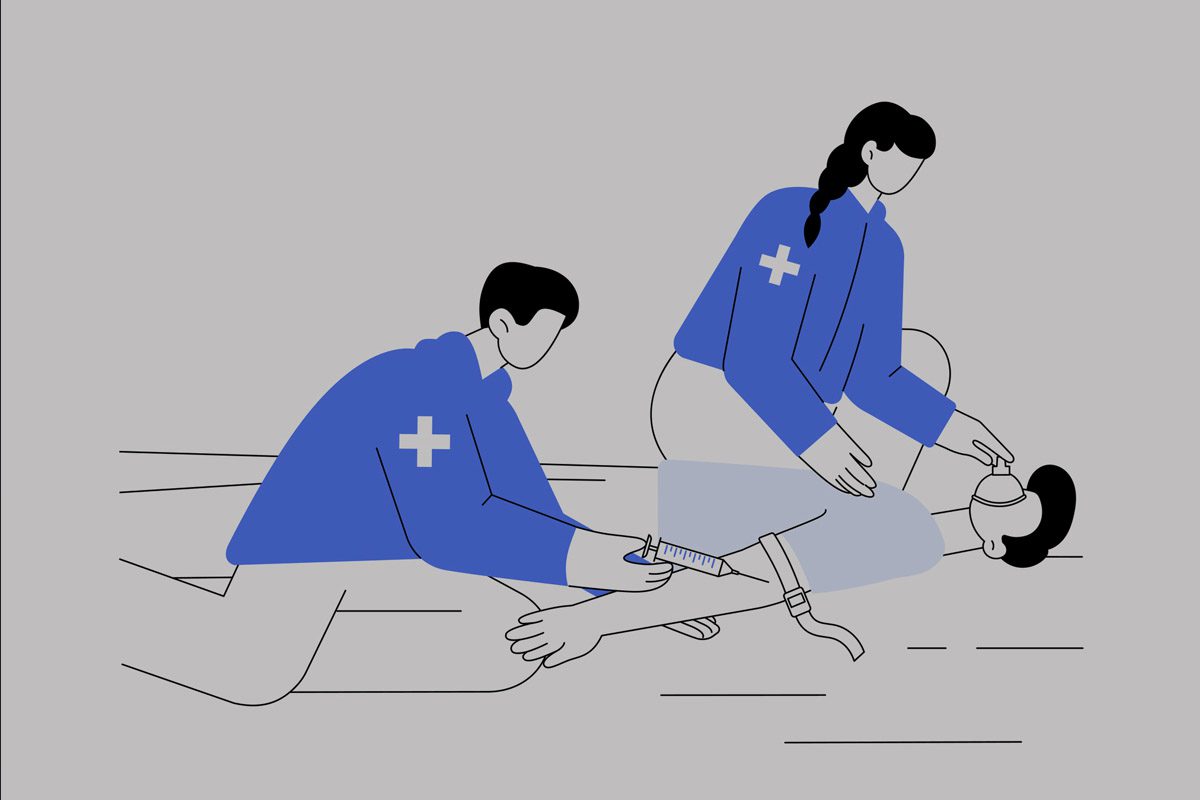Sensorineural hearing loss is an infrequently recognized side effect of pain medication abuse. Chronic pain patients treated with opiates develop different degrees of tolerance to pain medications. In many cases, the tolerance becomes the gateway to a variety of cycles of overuse and unmasking of significant psychiatric morbidity and mortality. An individualized approach utilizing combined treatment modalities (including nonopiate pharmaceuticals) is expected to become the norm. Patients can now be provided with multidisciplinary care that addresses an individual’s psychiatric, social, and medical needs, which requires close cooperation between physicians of varying specialties. This report describes a patient who experienced hearing loss from hydrocodone/acetaminophen abuse.

Implications of Sensorineural Hearing Loss With Hydrocodone/Acetaminophen Abuse

ABSTRACT
Sensorineural hearing loss is an infrequently recognized side effect of pain medication abuse. Chronic pain patients treated with opiates develop different degrees of tolerance to pain medications. In many cases, the tolerance becomes the gateway to a variety of cycles of overuse and unmasking of significant psychiatric morbidity and mortality. An individualized approach utilizing combined treatment modalities (including nonopiate pharmaceuticals) is expected to become the norm. Patients can now be provided with multidisciplinary care that addresses an individual’s psychiatric, social, and medical needs, which requires close cooperation between physicians of varying specialties. This report describes a patient who experienced hearing loss from hydrocodone/acetaminophen abuse.
Prim Care Companion CNS Disord 2015;17(5):doi:10.4088/PCC.15br01809
© Copyright 2015 Physicians Postgraduate Press, Inc.
aDepartment of Psychiatry, University of California, Irvine
*Corresponding author: Robert G. Bota, MD, MSG, Department of Psychiatry, University of California Irvine, 101 City Drive, Orange, CA ([email protected]).
Sensorineural hearing loss is an infrequently recognized side effect of pain medication abuse. If recognized early, treatment is started with a high dose of prednisone followed by a course of pentoxifylline.1 Most people with hearing loss secondary to hydrocodone/acetaminophen abuse will need a cochlear implant.2 In a study by Oh and colleagues,3 2 young and otherwise healthy patients addicted to hydrocodone/acetaminophen developed rapidly progressive hearing loss, and neither responded to high-dose prednisone. Ho et al4 reported that all patients in a case series had progressive hearing loss without vestibular involvement. Three patients had asymmetric hearing loss that progressed to profound hearing loss in months, with steroid treatment having no effect. Notably, the amount of hydrocodone the patients reported to consume ranged from 10 mg to 300 mg a day.4
Other studies have found sensorineural hearing loss as an effect of other pain medication abuse. Yorgason et al5 looked at the agent responsible for toxic destruction of cochlear sensory cells by using in vitro mouse cell lines. The study concluded that acetaminophen may be a causative agent of cell death, while hydromorphone seems to potentiate that effect, and l-carnitine partially prevented cell death. Acetaminophen combined with codeine leading to deafness has been reported in countries in which this medication can be purchased over-the-counter,6 and hearing loss also has been documented with oxycodone/acetaminophen abuse,7 after heroin injection,8 following polysubstance narcotic overdose,1 and with methadone abuse.9 Patients with chronic pain treated with opiates develop different degrees of tolerance to pain medications, and in many cases, the tolerance becomes the gateway to a variety of cycles of overuse and unmasking of significant psychiatric morbidity and mortality. We present a case that illustrates severe morbidity, including loss of hearing, from hydrocodone/acetaminophen abuse.

- Hearing loss is an infrequently recognized side effect of pain medication use and abuse.
- Most people with hearing loss secondary to hydrocodone/acetaminophen abuse will need a cochlear implant.
- It is estimated that over 25% of people have chronic pain.
CASE REPORT
Ms A, a 44-year-old unemployed woman on disability for back pain, lives with her boyfriend of 10 years and her disabled brother. She has been separated from her husband for over 10 years. Ms A was raised in a dysfunctional environment with an alcoholic father. After high school, she completed 2 years of community college. She first started taking diazepam and opiates at age 17 years after falling from a horse. She was initially given diazepam by her mother, who had taken it for years. Soon after, Ms A developed a pattern of serial abusive relationships, with a boyfriend being particularly abusive. As a result of the physical abuse, he was arrested and imprisoned. After being physically assaulted by her boyfriend, Ms A began abusing pain medications and anxiolytics to manage her pain and anxiety. She received no psychiatric care during this time. At one point, her general practitioner prescribed fluoxetine, which she discontinued shortly after beginning treatment, claiming that it was ineffective. Her physician later prescribed citalopram, but she did not fill the prescription. Ms A reported a history of panic attacks beginning in her late teens. The panic attacks were accompanied by tachycardia, chest pressure, hyperventilation, trembling, perspiration, racing thoughts, fear of dying, and fear of going crazy. Ms A avoided crowds and stopped shopping for fear of being judged or having another panic attack. She also had distinct episodes of depression but denied suicide attempts or suicidal gestures. She reported a history of episodes during which she was feeling "hyper," with a decreased need for sleep, racing thoughts, and flight of ideas. During such episodes, Ms A would wake up in the middle of the night to scrub walls and ceilings. She reported that such hyper episodes could last up to 3 days. Ms A also admitted to having body image distortions since her teens. She perceived herself as overweight and had a history of binge eating and induced vomiting.
In the last few months, Ms A had lost 40 lb through restrictive diet and exercise. At this admission, she was brought to the hospital via ambulance with an altered level of consciousness and had to be intubated in the emergency department due to respiratory insufficiency. A dopamine drip was started secondary to bradycardia and hypotension. The electrocardiogram revealed QT prolongations, X-ray of the lung revealed infiltrations on the left lower lobe, and head computed tomography revealed no acute intracranial abnormalities. The assessment suggested toxic encephalopathy secondary to benzodiazepine and narcotic overuse along with tricyclic and cannabis abuse. The psychiatry department was consulted for overdose assessment.
A psychiatric consult revealed a long history of prescription drug abuse. Ms A was obtaining opiates and benzodiazepines from multiple doctors and private pain clinics. Her drugs of choice were alprazolam, hydrocodone/acetaminophen, carisoprodol, buprenorphine/naloxone, and diazepam. In the 10 years prior to this psychiatric consultation, she had been admitted to several inpatient programs for detoxification. Also 10 years prior to this consultation, she developed unilateral hearing loss as a result of continuous hydrocodone/acetaminophen abuse, for which she required a cochlear implant. As of the date of the consultation, Ms A’s pattern of substance abuse continued.
DISCUSSION
Hearing loss is associated with opiate abuse; however, this statement, which is often used in the literature, needs further clarification. In 1 study, people with hydrocodone-caused hearing loss reported that daily use was from 10 mg to 300 mg.4 Patients develop a tolerance to the effects of pain medications, especially opiates, when treating chronic pain. Therefore, the dose could be high and not necessarily related to abuse. There is no literature clearly defining the differential risk between patients prescribed high doses of pain medications (including opiates) and abuse. Larance et al,10 who reviewed the literature regarding opioid treatment, recognized the need for consistency in international communication with terms such as hazardous use, extramedical use, opioid abuse, and diversion, especially with the overall increase in opioid prescription.
Ms A developed hearing loss due to opiate abuse. Despite the hearing loss, her abuse of controlled substances did not change much over the subsequent years. One important problem we should not ignore in treating substance abuse in clinical practice is the change in the attitude of providers regarding these patients—due to the chronic illness course, a sense of futility develops, and the treatment practice might change as the patient continues the relapsing/remitting cycle.11
Informed consent obtained before beginning opioid therapy can be considered a primary prevention of potential for future controlled substance abuse. Besides the initial consent, the ongoing dialogue between the provider and the patient promotes a collaborative relation, fostering an easier discussion of alternative therapies when needed12 and perhaps better opportunities in noticing deviations from prescribed use of medications. Therefore, informed consent needs to be an ongoing patient-centered approach, focusing on enhancing quality of life, while minimizing potential for undertreatment of pain as well as other adverse effects, diversion, and abuse.
A patient-centered approach is best provided with multidisciplinary care that addresses an individual’s psychiatric, social, and medical needs, which requires close collaboration among physicians of varying specialties.13 In most medical specialties, the team approach is deemed to render the best outcome.
Submitted: March 2, 2015; accepted May 5, 2015.
Published online: September 10, 2015.
Drug names: alprazolam (Xanax, Niravam, and others), buprenorphine (Subutex, Suboxone, and others), carisoprodol (Soma and others), citalopram (Celexa and others), diazepam (Diastat, Valium, and others), fluoxetine (Prozac and others), hydrocodone/acetaminophen (Anexsia, Norco, and others), hydromorphone (Dilaudid, Exalgo, and others), methadone (Methadose and others), oxycodone/acetaminophen (Roxicet, Oxycet, and others), prednisone (Rayos and others).
Potential conflicts of interest: None reported.
Funding/support: None reported.
Acknowledgments: The authors thank Bonita Jaros, PhD (Santa Ana College, Santa Ana, California) and Peter Bota (University High Irvine, California) for scientific editing. Dr Jaros and Mr Bota report no conflicts of interest related to the subject of this article.
REFERENCES
1. Schweitzer VG, Darrat I, Stach BA, et al. Sudden bilateral sensorineural hearing loss following polysubstance narcotic overdose. J Am Acad Audiol. 2011;22(4):208-214. PubMed doi:10.3766/jaaa.22.4.3
2. Friedman RA, House JW, Luxford WM, et al. Profound hearing loss associated with hydrocodone/acetaminophen abuse. Am J Otol. 2000;21(2):188-191. PubMed doi:10.1016/S0196-0709(00)80007-1
3. Oh AK, Ishiyama A, Baloh RW. Deafness associated with abuse of hydrocodone/acetaminophen. Neurology. 2000;54(12):2345. PubMed doi:10.1212/WNL.54.12.2345
4. Ho T, Vrabec JT, Burton AW. Hydrocodone use and sensorineural hearing loss. Pain Physician. 2007;10(3):467-472. PubMed
5. Yorgason JG, Kalinec GM, Luxford WM, et al. Acetaminophen ototoxicity after acetaminophen/hydrocodone abuse: evidence from two parallel in vitro mouse models. Otolaryngol Head Neck Surg. 2010;142(6):814-819, 819, e1-e2. PubMed doi:10.1016/j.otohns.2010.01.010
6. Blakley BW, Schilling H. Deafness associated with acetaminophen and codeine abuse. J Otolaryngol Head Neck Surg. 2008;37(4):507-509. PubMed
7. Rigby MH, Parnes LS. Profound hearing loss associated with oxycodone-acetaminophen abuse. J Otolaryngol Head Neck Surg. 2008;37(6):E161-E162. PubMed
8. Schrock A, Jakob M, Wirz S, et al. Sudden sensorineural hearing loss after heroin injection. Eur Arch Otorhinolaryngol. 2008;265(5):603-606. PubMed doi:10.1007/s00405-007-0495-6
9. Saifan C, Glass D, Barakat I, et al. Methadone-induced sensorineural hearing loss. Case Rep Med. 2013;2013:242730. PubMed
10. Larance B, Degenhardt L, Lintzeris N, et al. Definitions related to the use of pharmaceutical opioids: extramedical use, diversion, nonadherence and aberrant medication-related behaviors. Drug Alcohol Rev. 2011;30(3):236-245. PubMed doi:10.1111/j.1465-3362.2010.00283.x
11. Bota RG. What we know about ourselves: changing attitudes about treating patients with substance use disorders. South Med J. 2006;99(1):11. PubMed doi:10.1097/01.smj.0000197042.98938.46
12. Cheatle MD, Savage SR. Informed consent in opioid therapy: a potential obligation and opportunity. J Pain Symptom Manage. 2012;44(1):105-116. PubMed doi:10.1016/j.jpainsymman.2011.06.015
13. Fedoroff IC, Blackwell E, Speed B. Evaluation of group and individual change in a multidisciplinary pain management program. Clin J Pain. 2014;30(5):399-408. PubMed
Please sign in or purchase this PDF for $40.00.





